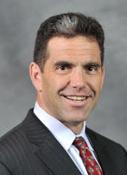 Daniel Resnick, MD, MS, professor and vice chairman of neurological surgery at the University School of Medicine and Public Health in Madison, shares insight on the latest developments in the North American Spine Society spine registry.
Daniel Resnick, MD, MS, professor and vice chairman of neurological surgery at the University School of Medicine and Public Health in Madison, shares insight on the latest developments in the North American Spine Society spine registry.
The North American Spine Society has been working with several organizations, including the AANS/CNS Joint Section on Spine, International Spine Intervention Society, Scoliosis Research Society, International Society for Advancement of Spine Surgery and American Academy of Orthopaedic Surgeons, to create a national spine registry. The collaboration is designed to improve quality of patient care. Dr. Resnick discusses the upcoming pilot test, the project's applications and how surgeons will be able to work with the registry.
Q: How does the registry's progress compare to your initial expectations?
Dr. Daniel Resnick: The design of the registry has been set for some time. From the NASS perspective, we have been ready to launch for about a year. We ran into communication issues with our vendor and ended up switching. We are now in the process of installing outcome measures into the platform.
Q: What applications will the registry have when it is fully up and running?
DR: The main purpose, and advantage, of the registry is to serve as clinical registry for all spine care providers. The platform can also be used as a post-marketing analysis tool. It can be a tool in individual research projects, as well. The registry will hopefully become an industry standard.
Q: How does patient involvement play into this project?
DR: The registry is going to primarily serve as a quality improvement project, like American College of Surgeons National Surgical Quality Improvement Program for example. As such, it is exempt from a patient permission requirement. If individual surgeons or practices decide to use the information for a clinical study, they will have to obtain patient permission.
Q: Have there been any stumbling blocks along the way?
DR: The main stumbling block we've run into was the inability to get the product online to be used. We've held hours of discussion on how to do it and as I mentioned before we switched vendors. We now expect to have it up and running by the New Year. We will begin with a pilot study, which will involve 20 sites used mostly by NASS surgeons. Any further obstacles will become apparent then.
Q: Are there any challenges you foresee for the project after it is launched?
DR: We are trying to make involvement economically feasible. Access to the registry will not cost thousands of dollars. One of our biggest concerns is with the difficulty of obtaining adequate patient follow-up.
Q: How will spine surgeons interact with the registry?
DR: The main concern we have had is the reporting burden that is associated with the registry. We are trying to make it as easy as possible. Patients will do as muchas possible, easing the burden on clinicians. Participating physicians will only be required to provide a diagnosis, share any procedure performed and indicate complications, if any. It is really up to the surgeons and providers how much they get out of it. You get out what you put in.
Q: What benefits do you expect to see after the registry is launched?
DR: Every single registry has resulted in improve patient care and that is what we expect to see here.
More Articles on Spine:
Defining Value in Spine Surgery & Care: What to Know for 2014
Will SGR Repeal Happen This Year? NASS Weighs In
See More Patients Per Day: 5 Organizational Tips for Spine Surgeons


